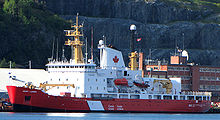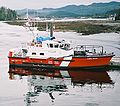Canadian Coast Guard
|
|||
|---|---|---|---|
| State level | Federal level | ||
| Position of the authority | Coast guard | ||
| Supervisory authority (s) | Fisheries and Oceans Canada | ||
| Consist | since January 26, 1962 | ||
| Headquarters |
Ottawa , Ontario , Canada |
||
| Canadian Coast Guard Commissioner | Jeffery Hutchinson | ||
| Employee | ~ 4,750 | ||
| Website | www.ccg-gcc.gc.ca | ||

The Canadian Coast Guard ( French Garde côtière canadienne , English Canadian Coast Guard , CCG for short ) is the coast guard of Canada with headquarters in Ottawa , Ontario . It reports to the Minister of Fisheries, Oceans, and the Canadian Coast Guard .
Their duties include rescuing people from distress at sea (National Search and Rescue Program) , setting up and maintaining sea marks , preventing and combating oil spills and operating icebreakers .
Border protection (with the world's longest coastline in any country: 202,080 km) is the responsibility of the Royal Canadian Navy , while the Royal Canadian Mounted Police (RCMP) carries out federal police duties on land and at sea.
history
Early history (1867–1962)
Before the founding of the Canadian Coast Guard , various government agencies, including the Royal Canadian Navy, performed the duties of the current Coast Guard. After the Canadian Confederation in 1867, the Canadian government at the time assigned several tasks to ensure the safety of the coastal strip. In addition to rescue operations, this also included maintenance of the lighthouses . The government subordinated these tasks to the Department of Marine and Fisheries, with some additional responsibilities in monitoring various rivers and shipping lanes. As part of the Canadian Lifesaving Service, lifeboats were stationed on the east and west coasts so that they could get to the scene quickly to rescue the shipwrecked.
After the Department of Marine and Fisheries was split into two separate ministries, the Department of Marine took over responsibility for the Coast Guard. After the Second World War , shipping expanded in the Canadian coastal regions. Especially after the opening of the St. Lawrence Seaway , freight traffic in the region increased. By resolution of the government of Prime Minister John Diefenbaker , the maritime tasks of the Ministry of Transport (DOT) were bundled by establishing a Canadian Coast Guard as a subdivision of the DOT on January 26, 1962 with the Canadian Coast Guard .
Expansion (1962–1990)
With the opening of more shipping lanes, a period began in which the Canadian Coast Guard expanded between 1960 and 1980. The aging coast guard ships have been decommissioned and replaced by new ones to better cope with the tasks. Orders to build new ships, which were delivered by the end of the 1970s, were awarded to Canadian shipyards. The Canadian government has set up several coast guard stations, most of which are located near major ports and along shipping routes in southern Canada - such as Victoria in British Columbia , Dartmouth in Nova Scotia and in the Parry Sound District in Ontario .
organization
The Canadian Coast Guard is under the direction of a Commissioner of the Canadian Coast Guard , Jeffery Hutchinson since March 2017. The Deputy Commissioners (Strategy and Shipbuilding) and Deputy Commissioners (Operations) as well as the Assistant Commissioners and Directors General and their subordinate departments report to him. The Commissioner of the Canadian Coast Guard reports to Deputy Minister Fisheries and Oceans Canada .
The Coast Guard is divided into three regions:
- Western region
- Central and Arctic Region
- Atlantic region
Canadian Coast Guard Auxiliary
The Canadian Coast Guard Auxiliary (CCGA) , formerly the Canadian Marine Rescue Auxiliary (CMRA), is a non-profit organization within the Coast Guard operated by volunteers and fishermen. The CCGA supports the Canadian Coast Guard in the search and rescue of castaways off the coast of Canada. Safety courses are also offered. The CCGA only pays the cost of fuel and a flat-rate rental fee for the fishing boats that take part in search and rescue operations. The volunteers are primarily deployed in remote areas where the Canadian Coast Guard does not have a base.
The Canadian Coast Guard is responsible for security along the coast. For this reason, it operates the world's largest network of buoys , lighthouses and fog horns . These facilities help ships and boats to navigate safely on the open sea.
The lighthouses were automated by the CCG from 1968, with the result that lighthouse keepers have been superfluous since the 1990s. The number of lighthouse keepers who were still in British Columbia , Newfoundland and Labrador, and New Brunswick has been reduced to a handful.
As a result of budget cuts and technological advances in shipping - such as GPS , electronic navigation maps, and the Global Maritime Distress Safety System - the Canadian Coast Guard has decommissioned old navigation systems such as fog horns and some lighthouses.
Marine Communications and Traffic Services
For the shipping industry, the Canadian Coast Guard operates communication centers that offer various services. This includes a weather service as well as information on swell and shipping traffic in narrow passages. The areas of responsibility of the centers are spread over the coasts along the Pacific (Pacific Region) , the Inland Territories, Northwest Territories and Nunavut (Central and Arctic Region) , in the Quebec Region , New Brunswick and Nova Scotia (Maritime Region) and in the Newfoundland and Labrador Region . These can be reached by calling the mobile maritime radio service ( Maritime Mobile Service Identity , MMSI). Example for the Pacific Region :
Pacific region
| Location | Callsign | MMSI |
|---|---|---|
| Commox | VAC | 003160014 |
| Prince Rupert | VAJ | 003160013 |
| Tofino | UAE | 003160012 |
| Vancouver | VAS | 003160010 |
| Victoria | VAC | 003160011 |
Current fleet
The fleet includes 121 watercraft as well as 22 helicopters and some airplanes. The Canadian Coast Guard ships and boats carry the prefix CCGS for Canadian Coast Guard Ship , as do the five Coast Guard hovercraft .
CCGS Hudson , research vessel
CCGS Bell 206
New ships
On September 9, 2009 it was announced that the Canadian Coast Guard will receive nine new Coast Guard vessels from the Mid-Shore Patrol Vessel Project series (now Hero-class patrol vessels ), which will complement the existing fleet. The first ship was delivered to the Canadian Coast Guard in 2012. The delivery of all Hero-Class ships was completed on schedule by 2014. The contract was worth 194 million Canadian dollars.
The CCGH Mamilossa , based at Trois-Rivières, QC, is a new, purpose-built Coast Guard hovercraft. The hovercraft is also used to keep the St. Lorenz fairway clear of ice fields.
As part of the National Shipbuilding Strategy of the Government of Canada , it was decided that the Coast Guard should receive more new ships.
The program includes a .:
- 3 Offshore Fisheries Science Vessels for the offshore fishing service, with which the older ships CCGS Teleost, CCGS Alfred Needler and CCGS WE Ricker are to be replaced. The ships are being built by Seaspan's Vancouver Shipyards and the arrival is scheduled for the end of 2019. The first ship, the CCGS Sir John Franklin , was handed over in December 2017.
- 1 Offshore Oceanographic Science Vessel for oceanographic and hydrographic research to replace the CCGS Hudson . The ship is being built by Seaspan in Vancouver and is scheduled to arrive in late 2021-early 2022.
- 5 offshore patrol vessels for regular patrol service. The admission is planned for the end of 2019.
The program also includes the new icebreaker CCGS John G. Diefenbaker, which is to replace the CCGS Louis S. St-Laurent in 2021 or 2022 .
As part of its own construction program, the coast guard
Facilities
The Coast Guard has its own central educational institution, the Canadian Coast Guard College (CCGC) Westmount ( Cape Breton Regional Municipality ) near Sydney in the province of Nova Scotia.
The CGC maintains the following bases ( CCG Base ) and stations ( CCG Station ):
-
Newfoundland Region ( Newfoundland )
- CCG Base St. John's - St. John's
- CCG Station St. Anthony - St. Anthony
- CCG station Port au Choix - Port au Choix
- CCG Lark Harbor Station - Lark Harbor
- CCG Station Burgeo - Burgeo
- CCG Station Burin - Burin
-
Maritime region
- CCG Base Charlottetown - Charlottetown (Prince Edward Island)
- CCG Base Dartmouth - Dartmouth (Nova Scotia)
- CCG Base Saint John - Saint John (New Brunswick)
- CCG Shippagan Station - Shippagan (New Brunswick)
- CCG Station Summerside - Summerside (Prince Edward Island)
- CCG Station Souris - Souris (Prince Edward Island)
- CCG Station Louisbourg - Louisbourg (Nova Scotia)
- CCG Station Bickerton - Bickerton East (Nova Scotia)
- CCG Station Sambro - Sambro (Nova Scotia)
- CCG Station Clark's Harbor - Clark's Harbor (Nova Scotia)
- CCG Station Westport - Westport (Nova Scotia)
- Canadian Coast Guard College - Westmount, Nova Scotia
-
Quebec Region ( Quebec )
- CCG Base Québec - Québec City
- CCG Base Sorel - Sorel
- CCG station Tadoussac - Tadoussac
- CCG station Havre-Saint-Pierre - Havre-Saint-Pierre
- CCG station Rivière-au-Renard - Rivière-au-Renard
- CCG station Cap-aux-Meules - Cap-aux-Meules
- CCG Hoverport Trois-Rivières - Trois-Rivières
-
Central and Arctic Region
- CCG Base Parry Sound - Parry Sound, Ontario
- CCG Base Prescott - Prescott, Ontario
- CCG Base Sarnia - Sarnia (Ontario)
- CCG Base Sault Ste Marie - Sault Ste. Marie (Ontario)
- CCG Base Thunder Bay - Thunder Bay, Ontario
- CCG Base Iqaluit - Iqaluit (Nunavut)
- CCG Base Hay River - Hay River (Northwest Territories)
- CCG Base Selkirk - Selkirk, Manitoba
- CCG Base Burlington - Burlington, Ontario
- CCG Sub-Base Amherstburg - Amherstburg (Ontario)
- CCG Sub-Base Kenora - Kenora (Ontario)
- CCG Station Cobourg - Cobourg (Ontario)
- CCG Station Kingston , Kingston (Ontario)
- CCG Station Port Weller - Port Weller (Ontario)
- CCG Station Port Dover - Port Dover (Ontario)
- CCG Station Tobermory - Tobermory, Ontario
- CCG Station Meaford , Meaford (Ontario)
- CCG Station Goderich , Goderich (Ontario)
-
Pacific Region ( British Columbia )
- Joint Rescue Coordination Center Victoria - CFB Esquimalt
- CCG Base Victoria - Victoria
- CCG Base Seal Cove - Prince Rupert
- CCG Base Patricia Bay - Sidney
- CCG Base PBS - Nanaimo
- CCG Sea Island Station - Richmond
- CCG Station Kitsilano , Vancouver
- CCG Powell River Station - Powell River
- CCG Station Ganges - Saltspring Island
- CCG station Tofino - Tofino
- CCG Station Bamfield - Bamfield
- CCG Station Port Hardy - Port Hardy
- CCG Campbell River Station - Campbell River
- CCG Station Bella Bella - Bella Bella
- CCG Station Sandspit - Sandspit
See also
Web links
- www.ccg-gcc.gc.ca: Official website (Engl./Franz.)
Individual evidence
- ↑ Canadian Coast Guard Commissioner , accessed September 22, 2017
- ↑ Integrated Business and Human Resources Plan 2015-2018 (English), accessed on September 22, 2017
- ↑ Canadian Coast Guard , Canadian Coast Guard
- ↑ Canadian Coast Guard - Regions , accessed November 28, 2018
- ↑ Canadian Coast Guard (www.ccg-gcc.gc.ca) - Fleet-Hub (English), accessed on June 23, 2017
- ↑ Canadian Coast Guard (www.ccg-gcc.gc.ca) - Mid Shore Patrol Vessel (English), last accessed April 4, 2019
- ↑ ARCHIVE dfo-mpo.gc.ca/media/npress-communique - Minister Shea Dedicates the New Hovercraft ACV Mamilossa
- ↑ Shipbuilding projects to equip the Royal Canadian Navy and the Canadian Coast Guard. Government of Canada , November 5, 2018, accessed November 28, 2018 .
- ↑ Canadian Coast Guard (www.ccg-gcc.gc.ca) - Canadian Coast Guard College , last accessed June 19, 2011
literature
- Charles D. Maginley: The Canadian Coast Guard 1962-2002. Vanwell Publishing Ltd., St. Catharines Ontario 2003. ISBN 1-55125-075-6 .














